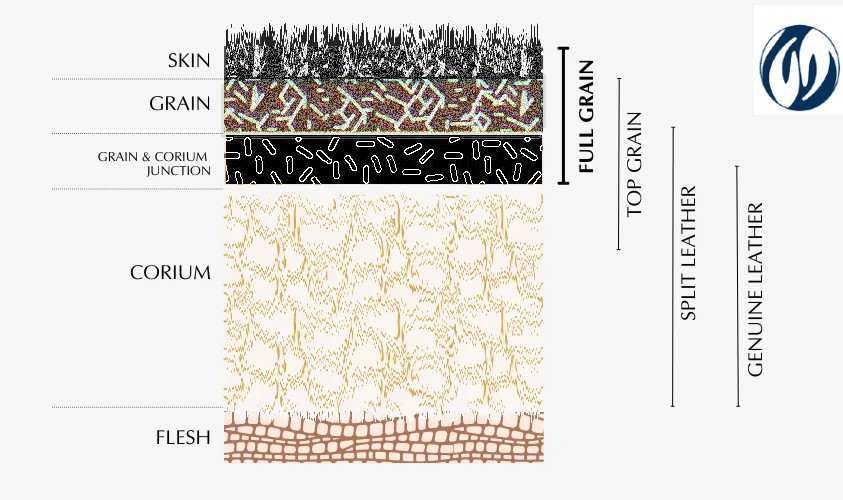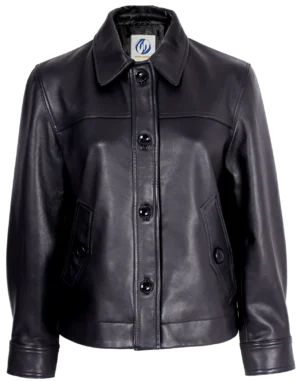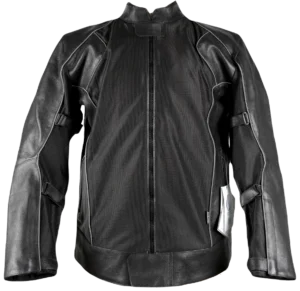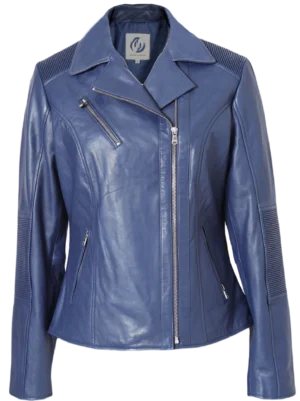Understanding leather types is crucial to navigating the ancient craft of leatherworking, where history and fascination intertwine. When distinguishing full-grain, top-grain, split-grain, and genuine leather during purchases, the terminology involved might need to be clarified. Many luxury brands selling leather jackets and bags market them as “genuine” or “real leather.” While this term sounds impressive, it is general and means that the leather is from animal hide and is not artificial. These brands cannot assert that their leather is top-quality, full-grain leather. This blog delves into different grades of leather, empowering you to make informed decisions when selecting the best type of leather for leather jackets.
The different types of leather with pictures are explained below:
Full-grain Leather
Full-grain leather features densely packed fibers, resulting in a finer grain. Typically, only the hide’s hair is removed, leaving natural imperfections in the material. Full-grain leather without imperfections is considered rare and highly valued in leather goods, especially leather jackets and shoes. This leather type is renowned for its exceptional durability. Due to its natural production process, it undergoes slight color changes with continued use.
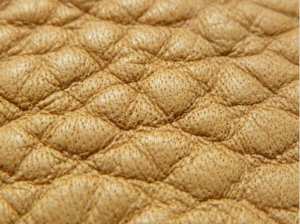 When you observe full-grain leather closely, you should be able to see the hair pores of the skin. Leather made from different animal species also varies in the structure of the hair pores. (Picture Courtesy: The Leather Dictionary).
When you observe full-grain leather closely, you should be able to see the hair pores of the skin. Leather made from different animal species also varies in the structure of the hair pores. (Picture Courtesy: The Leather Dictionary).
Full-grain leather possesses several distinctive qualities that distinguish it from other types of leather:
- Durability: It is renowned as the most resilient form of leather, lasting for decades when properly maintained.
- Natural Beauty: The leather’s original grain patterns, inherent imperfections, and unique characteristics from the animal’s skin remain visible, rendering each piece of full-grain leather distinct and authentic.
- Luxurious Texture: Full-grain leather boasts a soft, supple feel that exudes luxury and quality.
- Patina Development: With time and exposure to oils, sunlight, and environmental elements, full-grain leather naturally develops a rich patina. Patina leather refers to the beautiful aging process that occurs in full-grain leather. Over time, it develops a unique character, deeper color, and a subtle sheen, making it highly prized by leather enthusiasts. This process entails darkening and polishing the leather, enhancing its appearance and character.
It is renowned for its durability, natural beauty, and rich patina, making it the ideal choice for leather jackets, handbags, laptop bags, and backpacks that last a lifetime.
Top-grain Leather
Top-grain leather is similar to full-grain leather, sourced from the hide’s top layer. The key distinction lies in deliberately sanding or buffing the leather after removing the hair to eliminate imperfections like scars or cuts on the animal’s skin. Although it remains a high-quality material, it does not possess the same durability or natural appearance as full-grain leather. The buffing process results in leather that offers ease of dyeing or shaping. Despite this refinement, top-grain leather maintains its reputation as a high-end leather and sees extensive use in various consumer products such as wristwatches, handbags, wallets, book casings, and shoes.
Genuine Leather
The term “genuine leather” is often used to describe lower-quality leather products made from the less desirable parts of the hide and often treated with chemicals to give them a uniform appearance. The only truth about “Genuine Leather” is that it comes from an animal’s skin and is not synthetic. However, the term “genuine leather” can be misleading, as it is often used as a catch-all term for any leather product that contains traces of animal skin. While genuine leather is real leather, it makes it difficult for consumers to determine the leather quality they purchase. It is typically used for belts, clothing, footwear, and other fashion accessories. When buying leather products, it is vital to look for information about the cut and grade of the leather to determine its quality.
Split-grain Leather (Suede)
When the skin is divided into several layers across its entire surface, it is known as “splitting.” Split-grain leather comes from a cut made from the lower levels of the hide. It earns the name “split grain” because it utilizes the bottom material after splitting the hide. Typically, the hide from an animal with thicker skin, like a cow, which can range from 5 to 10 mm, is divided into layers. The top layer is the full-grain or top grain, while the bottom is the split grain. Although split-grain leather is less robust than top or full-grain, it can still serve a valuable purpose in fashion and home decor.
Different Types of Finished Leather and Their Properties
When it comes to leather, the finish can significantly impact its look, feel, and durability. Here, we explore the various types of finished leather and their unique characteristics.
Aniline Leather
Aniline leather is known for its natural beauty. Dyed exclusively with soluble dyes, this leather showcases the natural surface, including any blemishes or marks. Only high-quality hides are selected for aniline leather due to their even surface. A light protective coating is sometimes added to prolong durability and minimize staining, maintaining the leather’s authentic appearance.
Semi-Aniline Leather
Similar to aniline leather, semi-aniline leather is also dyed with soluble dyes. However, it includes a slight layer of pigmentation, which provides more uniformity while still allowing the natural grain to be visible. A thin protective coating enhances its resistance to wear and stains. This type strikes a balance between beauty and practicality.
Antique Grain Leather
Antique grain leather is crafted to exhibit an aged and worn look. This is achieved through multiple finishes or rubbing techniques to replicate natural wear over time. Ideal for those seeking a vintage aesthetic, this leather does not require the material to be genuinely old, making it perfect for stylish, timeless pieces.
Bicast Leather
Bicast leather features a split leather backing with a top layer of polyurethane or vinyl, giving it the appearance of high-end leather at a fraction of the cost. This finish is typically glossy and patterned, appealing to budget-conscious buyers. It’s a popular choice for furniture or fashion items where cost is a key consideration.
Brush Colored Leather
A creative touch is evident in brush-colored leather, where pigments are applied with a brush. This technique results in unique patterns with variations in gradient, blending, or tone, giving each piece a distinct look. It’s highly sought after for custom and artisanal products that aim for a personalized and artistic flair.
Chap Leather
Chap leather is known for its durability and flexibility. Chrome-tanned, these large hides are perfect for outdoor gear and equestrian equipment due to their resilience and lightweight properties. Ideal for garments like chaps, this type of leather is designed to endure harsh conditions and rigorous use.
In conclusion, understanding leather types is crucial, especially when shopping for leather jackets or bags. By understanding the properties of these various leather finishes, consumers can make informed choices tailored to their aesthetic preferences and functional needs.

